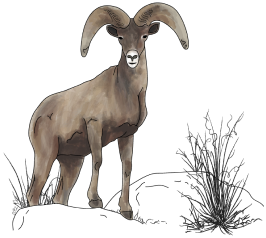Purshia stansburyana (Torr.) Henrickson
Eukaryota > Viridiplantae > Streptophyta > Streptophytina > Embryophyta > Tracheophyta > Euphyllophyta > Spermatophyta > Magnoliopsida > Mesangiospermae > eudicotyledons > Gunneridae > Pentapetalae > rosids > fabids > Rosales > Rosaceae > Dryadoideae >Purshia > Purshia stansburyana [1]
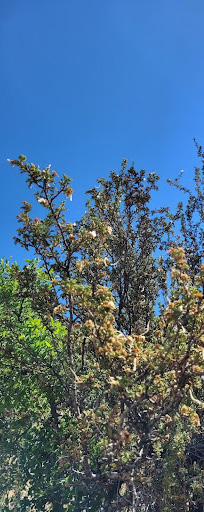
Image of Purshia stansburyana. Image by Kylee Larsen.
Perennial shrub or small tree, 0.6-3.5 m tall; branches numerous, reddish brown or gray, with shreddy bark; branchlets glandular. Leaves alternate, simple, 3-15 mm long, cuneate to flabellate (wedge to fan-shaped), mainly 5-lobed, thick, leathery, glandular-punctate and dark green above, white tomentose beneath, margins revolute. Pedicels 2-8 mm long. Inflorescence of solitary flowers arising at the ends of lateral branches. Flowers fragrant; hypanthium and sepals with stalked glands, sepals 4-6 mm long, ovate; petals 5, 5-9 mm long, white to cream or yellowish; pistils 5. Fruits achenes, 4-7 per ovary, 5-7 mm long, with a persistent style 2-6 cm long, whitish [2,4].
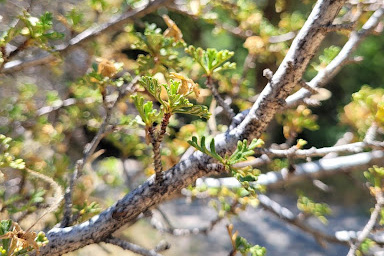
Leaves and branches of Purshia stansburyana. Image by Kylee Larsen.
Fallugia paradoxa and Purshia tridentata are similar to P. stansburyana: F. paradoxa has rusty to yellow pubescence on the undersides of the leaves, larger flowers, and as many as 25 achenes per flower, with feathery (plumose) persistent styles whereas P. stansburyana has white wooly pubescence on the undersides of the leaves and typically 4-7 achenes per flower, with feathery persistent styles [2]. Purshia tridentata has brown tomentose branches unlike the shreddy bark of P. stansburyana [3] and lacks feathery persistent styles on the fruit, having instead a pointed, hard apex.
Purshia stansburyana has a challenging taxonomic history, with some botanists recognizing it as Purshia mexicana var. stansburyana. The argument for P. stansburyana to be recognized as a distinct species comes from the observation that P. mexicana is only found in Mexico, and is said to have distinct morphological differences. Of course, some argue that the morphological differences are why P. stansburyana would be a variety of mexicana rather than be included in the normal range of differences within one species. As recent as 2015, A Flora of Utah, Fifth Edition, Revised, listed this plant as a variety of the mexicana species [3], but other reputable sources list it as its own species [2]. The discussion seems to be ongoing or recently decided, so it is helpful to know both names when identifying and studying this plant.
![Purshia stansburyana fruits [4].](/crfs/images/native-plants/plant-directory/cliffrose-identification1.jpg)
Purshia stansburyana fruits [4].
![Purshia tridentata young fruit [6]](/crfs/images/native-plants/plant-directory/cliffrose-identification3.jpg)
Purshia tridentata young fruit [6].
![Purshia tridentata bark [8].](/crfs/images/native-plants/plant-directory/cliffrose-identification5.jpg)
Purshia tridentata bark [8].
![Fallugia paradoxa fruit [5]](/crfs/images/native-plants/plant-directory/cliffrose-identification2.jpg)
Fallugia paradoxa fruit [5].
![Purshia stansburyana shreddy bark [7].](/crfs/images/native-plants/plant-directory/cliffrose-identification4.jpg)
Purshia stansburyana shreddy bark [7].
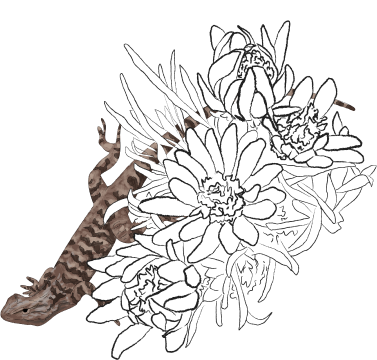
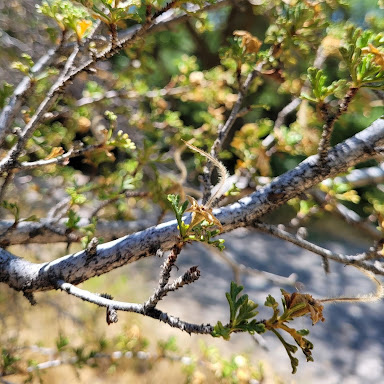
Image of the flowers of Purshia stansburyana. Image by Kylee Larsen.
Purshia stansburyana was used by many indigenous tribes. The Hopi used parts of the plant to wash wounds [10] and the bark as an emetic. They also used the fiber for making clothing, rugs, mats, and bedding and other parts of the plant for ceremonial items and hunting tools, including arrow shafts [11]. The Navajo also used the plant to make yellow and brown dyes. It is also noted that they would use the softened bark to stuff baseballs [12].
![Distribution map of Purshia stansburyana on a county level [13].](/crfs/images/native-plants/plant-directory/fremont-cottonwood-fourth.jpg)
Distribution map of Purshia stansburyana on a county level [13].
According to the IUCN Red list, P. stansburyana (as a variety of mexicana) is listed as ‘least concern’ [14].
Purshia stansburyana is a common plant in many plant communities found in Utah; including pinyon-juniper and sagebrush, grasslands, and ponderosa pine forests when the elevation is around 3,000- 8,000 ft. The substrate tends to be dry, and they do well on rocky slopes (hence the common name, Cliffrose). The drought resistant plant is a very important plant for wildlife browsing for animals such as deer, pronghorn and elk. Cliffrose is commonly used for restoration projects and erosion control. It is found in most counties in Utah. [2]
[1] Schoch CL, et al. NCBI Taxonomy: a comprehensive update on curation, resources and tools. Database (Oxford). 2020: baaa062. PubMed: 32761142 PMC: PMC7408187.
[2] Springer (Ed.). (2011). Purshia stansburyana. SEINet Portal Network -. Retrieved September 12, 2022, from https://swbiodiversity.org/seinet/taxa/index.php?taxon=purshia%2Bstansburyana&formsubmit=Search%2BTerms
[3] Welsh, Stanley L.; Atwood, N. Duane; Goodrich, Sherel; and Higgins, Larry C., "A Utah Flora, Fifth Edition, Revised" (2015). Books by Faculty of the Monte L. Bean Life Science Museum. https://scholarsarchive.byu.edu/mlbm/4
[4] Buren, R. V., Cooper, J. G., Shultz, L. M., & Harper, K. T. (2011). Woody Plants of Utah. Utah State University Press.
[5] Mayfield , T. (2021). Apache plume (Fallugia paradoxa). Photograph. https://commons.wikimedia.org/wiki/File:Fallugia_paradoxa_163852449.jpg
[6] Botany, A. (2017). Fruits forming on antelope bitterbrush (Purshia tridentata). photograph, Idaho Botanical Garden. https://awkwardbotany.com/2017/03/29/seed-dispersal-via-caching-the-story-of-antelope-bitterbrush/
[7] Alexander, P. (2017). Purshia stansburiana, between Lordsburg Mesa and the GIla River, north-northeast of Caprock Mountain near Corral Canyon. photograph, Hidalgo County, New Mexico, .https://commons.wikimedia.org/wiki/File:Purshia_stansburiana_-_Flickr_-_aspidoscelis_(3).jpg
[8] Zharkikh , A. (2016). Antelope bitterbrush (Purshia tridentata), Rose family (Rosaceae). photograph, Red Butte Garden Natural Area, Salt Lake City, Utah. https://commons.wikimedia.org/wiki/File:2016.03.04_13.19.36_DSC02902_-_Flickr_-_andrey_zharkikh.jpg
[9] Desert Elfin, Callophrys Fotis. California Native Plant Society. (2019). https://calscape.org/lep/Callophrys-fotis-(Desert-Elfin)?srchcr=sc5d5f670b82065
[10] Colton, Harold S., 1974, Hopi History And Ethnobotany, IN D. A. Horr (ed.) Hopi Indians. Garland: New York., page 304
[11] Whiting, Alfred F., 1939, Ethnobotany of the Hopi, Museum of Northern Arizona Bulletin #15, page 34, 78
[12] Elmore, Francis H., 1944, Ethnobotany of the Navajo, Sante Fe, NM. School of American Research, page 53
[13] USDA, NRCS. 2022. The PLANTS Database (http://plants.usda.gov, 09/28/2022). National Plant Data Team, Greensboro, NC USA.
[14] Carrero, C. 2020. Purshia stansburiana. The IUCN Red List of Threatened Species 2020:e.T138296177A159491089.https://dx.doi.org/10.2305/IUCN.UK.2020-1.RLTS.T138296177A159491089.en. Accessed on 21 March 2024.



